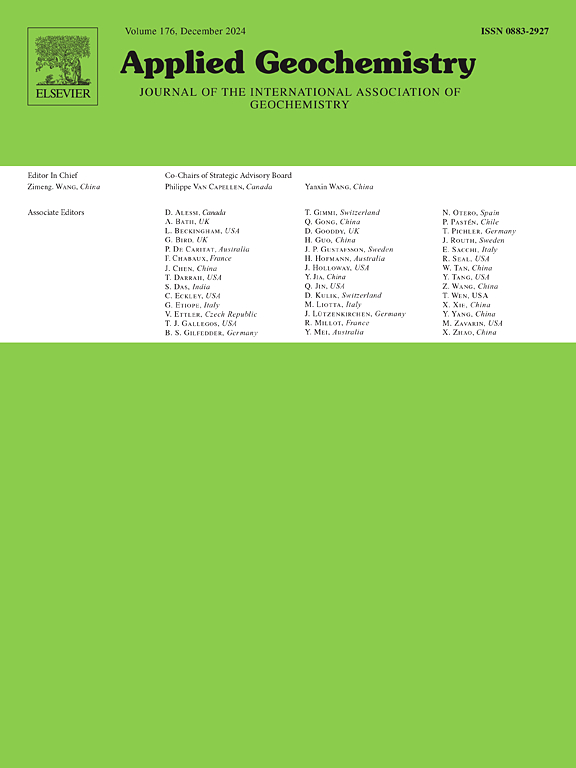Natural kaolin minerals with varying iron contents reduced cattle's enteric methane generation in vitro
IF 3.4
3区 地球科学
Q1 GEOCHEMISTRY & GEOPHYSICS
引用次数: 0
Abstract
Kaolin, a dominant mineral group in geophagic soil, often contains iron impurities that incur purification costs. Valorizing kaolin for livestock applications like ruminant methane (CH4) suppression without purification is promising but not well studied. This study used two kaolin clay samples collected from a Western Australia deposit, and tested their inclusion in a basal diet for CH4 inhibition in an in vitro animal model using viable cattle rumen fluid and paunch. Physicochemical characterization showed that one clay sample (Kao) had kaolinite as the dominant mineral species and a trace of halloysite, while another one had additional minerals and impurities such as iron oxides and illite/mica (KaoFe). Regardless of the CH4 produced by the basal diet, an approximately 5 % inclusion of clays significantly reduced enteric CH4, with reductions of 23 % (Kao) and 37 % (KaoFe) compared to the control. On average, the in vitro digestibility (IVD), coefficient of fermentation efficiency (CFE), microbial crude protein (mCP), and ammonia nitrogen (NH3–N) were 64 %, 77 %, 144 g/kg DM, and 21 g/kg DM, respectively. These results showed no significant differences between clay-treated and control groups, which indicates the clay's non-toxic nature in the rumen. Biochemical and physicochemical parameters and their correlations suggest that clay inclusion in the basal diet increased hydrogen sinkers, such as propionic acid and CH4 inhibitory ions, such as Al3+, Si4+, Fe2+/Fe3+, and K+. And the inclusion of the KaoFe sample contributed to more of these. Given that the cattle naturally ingest soil minerals through geophagy with good palatability, this study emphasizes the potential valorization of natural kaolin clays as feed supplements. It advances a cost-effective and biocompatible feed additive for rumen CH4 abatement without adversely affecting the digestive system.

不同铁含量的天然高岭土矿物在体外降低了牛的肠道甲烷生成
高岭土是土蚀性土壤中的主要矿物群,通常含有铁杂质,产生净化成本。高岭土在家畜中的应用前景广阔,如抑制反刍动物甲烷(CH4)而不进行净化,但尚未得到充分研究。本研究使用了从西澳大利亚沉积物中收集的两种高岭土样品,并在体外动物模型中使用活牛瘤胃液和腹部测试了它们在基础日粮中对CH4的抑制作用。理化性质分析表明,一种黏土样品(Kao)以高岭石为主要矿物,并含有少量高岭石,另一种黏土样品(KaoFe)含有氧化铁和伊利石/云母等矿物和杂质。无论基础日粮产生的CH4如何,添加约5%的粘土显著降低了肠道CH4,与对照组相比,减少了23%(花黄)和37%(花黄)。体外消化率(IVD)、发酵效率系数(CFE)、微生物粗蛋白质(mCP)和氨氮(NH3-N)平均分别为64%、77%、144 g/kg DM和21 g/kg DM。这些结果显示,粘土处理组与对照组之间无显著差异,表明粘土在瘤胃中无毒。生化和理化参数及其相关性表明,基础饲粮中粘土包裹体增加了丙酸和CH4抑制离子Al3+、Si4+、Fe2+/Fe3+和K+等氢沉物。KaoFe样本的加入促成了更多的这些。鉴于牛通过食土自然摄取土壤矿物质,具有良好的适口性,本研究强调了天然高岭土作为饲料补充物的潜在价值。该研究提出了一种具有成本效益和生物相容性的饲料添加剂,用于减少瘤胃CH4,而不会对消化系统产生不利影响。
本文章由计算机程序翻译,如有差异,请以英文原文为准。
求助全文
约1分钟内获得全文
求助全文
来源期刊

Applied Geochemistry
地学-地球化学与地球物理
CiteScore
6.10
自引率
8.80%
发文量
272
审稿时长
65 days
期刊介绍:
Applied Geochemistry is an international journal devoted to publication of original research papers, rapid research communications and selected review papers in geochemistry and urban geochemistry which have some practical application to an aspect of human endeavour, such as the preservation of the environment, health, waste disposal and the search for resources. Papers on applications of inorganic, organic and isotope geochemistry and geochemical processes are therefore welcome provided they meet the main criterion. Spatial and temporal monitoring case studies are only of interest to our international readership if they present new ideas of broad application.
Topics covered include: (1) Environmental geochemistry (including natural and anthropogenic aspects, and protection and remediation strategies); (2) Hydrogeochemistry (surface and groundwater); (3) Medical (urban) geochemistry; (4) The search for energy resources (in particular unconventional oil and gas or emerging metal resources); (5) Energy exploitation (in particular geothermal energy and CCS); (6) Upgrading of energy and mineral resources where there is a direct geochemical application; and (7) Waste disposal, including nuclear waste disposal.
 求助内容:
求助内容: 应助结果提醒方式:
应助结果提醒方式:


